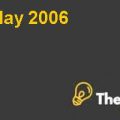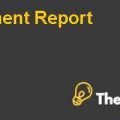1. Cost of Capital
Cost of Capital and Its Importance
Every Company needs finance to conduct its business effectively. Companiesmainly use equity and debt source for the financing purpose.Both of the Sources required some returns if company raise entire finance through equity source then it has to calculate thecost of equity and if the company use debt source for financing purpose then it has to calculate thecost of debt. However, most of the time company use both sources for financing purpose in this situation company has to calculate theweighted average cost of capital (WACC). The cost of capital is the rate which company has to earn so that it can fulfill its obligation regarding the required return of the capital providers.
Companies must calculate the cost of capital becauseit will help them in evaluating and selecting different opportunities. After calculating thecost of capital, thecompany will have a benchmark which can be used to compare different opportunities and the opportunity which has a high return than thecost of capital can be chosen by the companyto enhance the overall value of the company. Furthermore, after calculating the cost of capital, thecompany can estimate its future liabilities effectively. Which will help in reducing the potential penalties that can be occurred due to non-payment of return to finance provider (mainly to debt provider)?
EnCana Corporation-The Cost of Capital Case Solution & Answer
2. Capital Structure of EnCana
a. EnCana Source of Finance
The Capital Structure of EnCanaconsists both equity and debt finance. From which debt portion is approximately 33% remaining being equity portion. The debt of EnCana consists both short-term debt and long-term debt which are interest bearing debts. On the other side, the equity portion consists common stock and retained earnings.
b. Market Value of EnCana Equity
The market value of EnCana’s equity is calculated using the P/E ratio. P/E ratio is multiplied by earnings of the company to calculate market value.
| Market Value of Equity | ||||
| Book Value | Share Price | No. of Shares outstanding | Market Value | |
| Share capital | 5,264 | 52.50 | 854.9 | 44881 |
| Retained earnings | 10,743 | 10743 | ||
| Total | 16,007 | 55624 | ||
c. Market Value of EnCana Debt
To calculate the market value of EnCana’s debt we assume that they are issued and redeemed at par. And we take anaverage of interest rates and maturity times of public related debts. Furthermore, we assume that the other long-terms debts will mature after 15 years and short-term debts will mature in 3 years.
| Market Value of Debts | |||||
| Book Value | Interest rate | Yield % | Maturity Years | Market Value | |
| Long-term debt | |||||
| Publicly traded, including current portion* | 5351 | 7.30% | 5.81% | 27 | 6425 |
| Other long-term debt | 1278 | 3.52% | 4.20% | 15 | 1183 |
| Total | 6,629 | 7607 | |||
| Short-term debt | |||||
| Bankers' Acceptances | 369 | 5.25% | 3.47% | 3 | 387 |
| Commercial Paper | 1056 | 3.67% | 3.47% | 3 | 1062 |
| Total | 1,425 | 1449 | |||
| Total long-term and short-term debt | 8,054 | 9057 | |||
3. Cost of Debt Financing
a. Effect of Different Debts on theCost of Capital
Debts holders require lower return than equity holders, therefore, debt finance is considered asthe cheapest way of finance.......................
This is just a sample partial work. Please place the order on the website to get your own originally done case solution











